Unveiling Ocean Conservation Through Art: Elizabeth 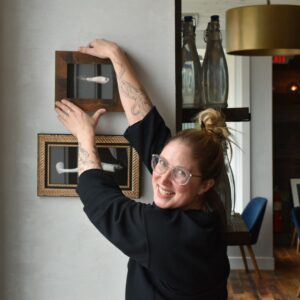 Ellenwood’s Exhibition
Ellenwood’s Exhibition
Join us at our on-site restaurant, The Shipwright’s Daughter, as we unite ocean conservation with art and activism during Earth Month and beyond.
Our team is excited to introduce “She Discovers The Sea,” an art exhibition by local artist Elizabeth Ellenwood. From now until the end of May, you can explore the exhibition while you dine.
Ellenwood addresses pressing issues such as marine debris, plastic pollution, and climate change through her art. Stay tuned as we delve into an exclusive Q&A session with the artist herself and learn more about her inspiration and vision.
Elizabeth Ellenwood: A Visionary Artist and Ocean Advocate
Elizabeth Ellenwood, also known as Among the Tides, is not just a photographer and educator but a Fulbright Scholar deeply committed to ocean conservation. Locally based in nearby Pawcatuck, CT, Ellenwood’s creative journey intertwines her profound passion for the ocean with her expertise in photography, resulting in thought-provoking imagery that compels us to take action.
 What inspired the fusion of your artistic expression with a deep concern for ocean conservation?
What inspired the fusion of your artistic expression with a deep concern for ocean conservation?
My combination of my artistic style with ocean conservation began in graduate school at Uconn the summer of 2018. Up until this point in my graduate career, I was making work that I wasn’t particularly excited about.. it just didn’t feel right.
So I eased my creative frustration with beach walks. These walks were therapeutic for me, I stopped thinking about classes, assignments, and life events that felt overwhelming. As I let my mind wander, I found myself collecting debris scattered along the shorelines. The sight of plastic bottles, caps, fragments, fishing gear, and bags both shocked and intrigued me.
One day, I decided to bring my collection back to my studio. Rather than using my beach walks as an escape from grad school, I began incorporating it into my practice of raising awareness of ocean conservation through art. Given my fondness for historical photographic processes, I began creating cyanotype photograms of the beach trash.
Cyanotype Photography
One day, I decided to bring my collection back to my studio, and rather than using my beach walks as an escape from grad school, I began incorporating them into my practice. Given my fondness for historical photographic processes, I began creating cyanotype photograms of the beach trash.
(Interested in learning more about this type of photography? Check out her local cyano workshops on May 19th and June 30th!)
Dating back to 1842, this process utilizes iron-based chemistry sensitive to sunlight, developing in water. The results were promising, and with each print, the work resonated more deeply with me. I had discovered a niche where I could utilize my passion and skills in photography to convey the importance of ocean conservation.
Since that summer, I’ve continued to merge my dual passions of art and the ocean. This journey has connected me with incredible individuals and breathtaking locales, all inspiring and informing my future projects.
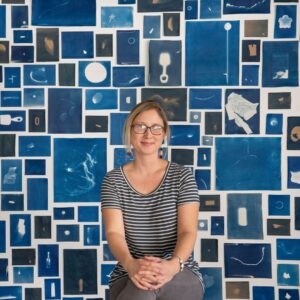 Can you share the story behind one of your most meaningful works and the message you aimed to convey?
Can you share the story behind one of your most meaningful works and the message you aimed to convey?
One word: nurdles! And what is a nurdle, you might be wondering? Well, it is “primary plastic”—the raw form of plastic before it is molded into its final object, like a bottle.
While on my Fulbright Scholarship in Norway, I stumbled upon these during my research and had my first impactful experience with them.
Sitting on a beach just outside of Oslo, I began pushing the sand around, only to discover perfectly round plastic pieces the size of lentils. Returning to the same beach, I collected over 1,000 nurdles. Photographing them under a microscope, I created little “portraits” of each individual specimen. I believe it’s crucial for people to understand the complexity of nurdles as marine debris.
Their small size makes it incredibly difficult for them to separate from the environment and poses deadly risks to fish and birds who mistake them for food. What’s more alarming is that they are already becoming pollutants before they even reach their final plastic form. This presents a significant challenge, especially considering their global distribution.
Upon returning to the States, I found nurdles after major storms at Napatree Point and Fenway Beach. It’s imperative that we comprehend the entire lifecycle of plastic—from its creation and the chemicals involved in its production to its use and eventual disposal.
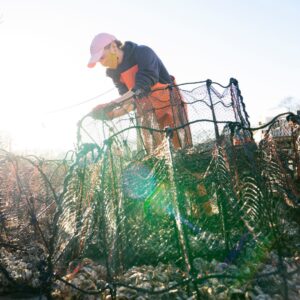 How do you approach merging art with activism, and what challenges have you encountered in ensuring your message resonates with your audience?
How do you approach merging art with activism, and what challenges have you encountered in ensuring your message resonates with your audience?
In my artistic research, I adopt a few different approaches. Sometimes, I explore issues that resonate with me personally, such as a specific piece of collected marine debris.
Other times, I delve into topics that are currently prominent in public discourse, such as local bottle bills or coral bleaching events. Additionally, I draw inspiration from my geographical location, whether it’s specific storms or sea level changes.
Sometimes, it is challenging to focus on one issue as there are so many problems our environment is currently facing. It is also hard not to get discouraged and depressed while doing this kind of work. As an artist, I always seek emotional impact from my work, but that can take a toll!
I don’t think I can ever ensure a message reaches everyone; that is not the way art works. I hope to present approachable work that at least invites various audiences to look at and think about as long as they want.
In your view, how can artists contribute to raising awareness and driving change regarding environmental issues?
Creativity knows no bounds, and the potential for innovation and solutions is abundant when given collaborative opportunities. My hope is that my artwork serves as a reminder and a starting point for conversations about ocean health and inspires greater concern and investment in preserving our marine ecosystems.
I firmly believe that artists deserve a seat at the table in larger conversations right from the outset of projects. 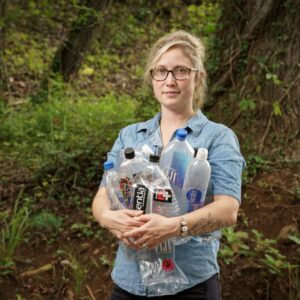 Our contributions extend far beyond the mere “end” communication of pre-existing studies or projects.
Our contributions extend far beyond the mere “end” communication of pre-existing studies or projects.
Involving artists at the ground level can infuse our unique perspectives and mindsets into the creative process. We possess the ability to inform opinions and offer fresh ideas for policy and regulations.
There is so much potential for artwork and the people who create it to live outside gallery walls! I think it would be extremely beneficial to have artists on various boards and as hired consultants for public outreach programs or education opportunities.
The ocean is a vast and endlessly fascinating subject. How do you decide which aspects or issues to highlight in your work, and are there any techniques or mediums you prefer to use to convey these themes best?
Every day, I find myself immersed in new discoveries about the ocean, much like the ever-evolving world of photography. The constant emergence of new equipment and processes in photography keeps the field endlessly fascinating. I am naturally curious, which is helpful when I get creatively stuck.
When seeking inspiration, I often explore new cameras or delve into research on historical photographic processes. Trusting my instincts, I follow my intuition down the rabbit hole, allowing it to guide me in deciding on aspects or issues to explore.
One such journey led me to develop my “Fading Reef” series, inspired by the anthotype process—a historical photographic technique that utilizes the light sensitivity of plants to create images. Initially experimenting with the process without a specific goal in mind, I found parallels between the anthotype process and my studies on coral reefs.
In this process, the print develops as sunlight destroys the pigment in exposed areas of the plant emulsion, resulting in a bleaching effect over time. This mirrors the devastating loss of pigment-rich algae crucial for coral survival. The delicate, time-sensitive anthotype prints in the “Fading Reefs” series serve as poignant reminders of the fragility of our ocean’s coral reefs.
Have you collaborated with environmental organizations, and if so, how has this influenced your work?
During my Fulbright project in Norway, I collaborated with scientists at the Norwegian Geotechnical Institute and the Fjord Clean Up Group. Immersed in their research and fieldwork, I gained valuable insights into plastic pollution and ocean conservation.
These collaborations enriched my understanding and provided real-world context for my work. Interacting with scientists and volunteers reinforced my sense of purpose and commitment to ocean conservation.
What upcoming projects or initiatives in ocean conservation are you excited about, and how do you envision your future work contributing to environmental preservation?
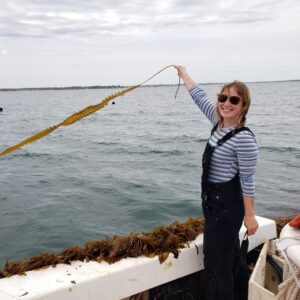 Seaweed!!!! The rising interest in seaweed as a solution to environmental challenges is remarkable.
Seaweed!!!! The rising interest in seaweed as a solution to environmental challenges is remarkable.
This trend is evident in both Norway and the United States, with initiatives such as eelgrass bed restorations and sugar kelp farming gaining traction. In locations like Oslo and Connecticut, there’s a concerted effort to explore the multifaceted benefits of seaweed.
Personally, I’m passionate about all things seaweed and have recently focused my artistic efforts on celebrating this sea vegetable. Through my photographs of seaweed, I aim to spark curiosity and serve as a gateway to this important topic.
My hope is that my artwork will serve as a reminder and a starting point for conversations about ocean health. By visually presenting the realities of our oceans, I aspire to inspire greater concern and investment in preserving our marine ecosystems.
Take Home a Piece of Ocean Inspiration: Art for Sale in Our 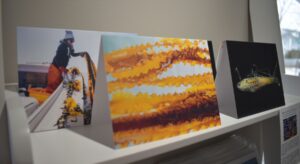 Lobby
Lobby
Extend the experience beyond the exhibition by purchasing a piece of Ellenwood’s artwork for sale in our lobby during your next getaway at Whaler’s!
Each piece tells a unique story of our ocean’s beauty and fragility, poignantly reminding us of our collective responsibility to protect it.
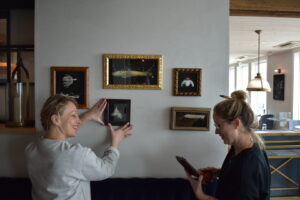 Join Us in Celebrating Ocean Conservation Through Art
Join Us in Celebrating Ocean Conservation Through Art
Explore the wonders of the sea and support its conservation through Elizabeth Ellenwood’s “She Discovers The Sea” exhibit at The Shipwright’s Daughter.
Join us in recognizing the ocean’s limitless splendor and durability as we champion preserving this vital resource for future generations.
For additional details and inquiries about purchasing artwork, kindly contact us at info@shipwrightsdaughter.com.
P.S: Want to unleash your own creativity? Dive into ocean conservation through art with Elizabeth’s cyano lessons on May 19th and June 30th. Learn more about these lessons on her site!
 Ellenwood’s Exhibition
Ellenwood’s Exhibition What inspired the fusion of your artistic expression with a deep concern for ocean conservation?
What inspired the fusion of your artistic expression with a deep concern for ocean conservation? Can you share the story behind one of your most meaningful works and the message you aimed to convey?
Can you share the story behind one of your most meaningful works and the message you aimed to convey? How do you approach merging art with activism, and what challenges have you encountered in ensuring your message resonates with your audience?
How do you approach merging art with activism, and what challenges have you encountered in ensuring your message resonates with your audience? Lobby
Lobby Join Us in Celebrating Ocean Conservation Through Art
Join Us in Celebrating Ocean Conservation Through Art Our contributions extend far beyond the mere “end” communication of pre-existing studies or projects.
Our contributions extend far beyond the mere “end” communication of pre-existing studies or projects. Seaweed!!!! The rising interest in seaweed as a solution to environmental challenges is remarkable.
Seaweed!!!! The rising interest in seaweed as a solution to environmental challenges is remarkable.